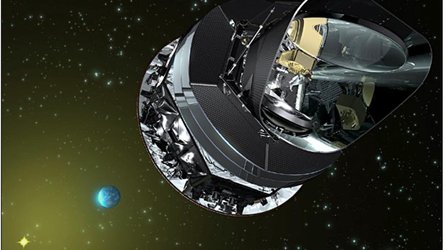The cosmic microwave background and inflation
How did the temperature fluctuations get there?
How exactly do the temperature fluctuations relate to density fluctuations?
How did the temperature fluctuations get there?
The period of time before the formation of the cosmic microwave background (CMB) plays a key role in determining how and why we see tiny fluctuations in the CMB. At the very beginning, the Universe underwent a rapid inflation that lasted only until 0.00000000000000000000000000000001 seconds (10-32 seconds). After inflation the size of the Universe had increased by a factor of about 1030 (1 followed by 30 zeroes – an enormous number!). Minute, random quantum fluctuations in the structure of the Universe that were present at the moment when inflation started, were amplified up to cosmologically large scales during inflation. Now the Universe comprised significantly large regions with slightly different properties from one to the other: in particular, the density of matter was slightly larger in some regions of the Universe than it was in others.
The slightly denser regions eventually grew increasingly denser, as gravity caused them to draw more and more matter from the surroundings. These primordial fluctuations in the density of matter in the early Universe are the seeds of the rich network of cosmic structure – stars, galaxies, galaxy clusters – that we observe today. It is thought that the fluctuations seen in the CMB are a result of the brief period of inflation. The exact details are hidden in the CMB, which Planck will be able to extract.
How exactly do the temperature fluctuations relate to density fluctuations?
Before the cosmic microwave background (CMB) was released, photons and ordinary particles were tightly coupled together, forming a single ‘fluid’ of matter and radiation. As soon as the two species decoupled from one another (at the time of recombination, 380,000 years after the Big Bang), photons started to propagate freely across the Universe, eventually reaching the detectors in the instruments on board Planck.
The photons carry a memory of how matter and radiation were distributed at the time of the decoupling. If, at the time of decoupling, a photon was in a slightly denser portion of space, it had to spend some of its energy against the gravitational attraction of the denser region to move away from it, thus becoming slightly colder than the average temperature of photons. Vice versa, photons that were located in a slightly less dense portion of space, lost less energy upon leaving it than other photons, thus appearing slightly hotter than average. This is why temperature fluctuations in the CMB reflect the pattern of structure in the matter that was present in the early Universe, right when the CMB was released. The CMB can therefore be considered as the ultimate snapshot of our Universe at the time of recombination.















 Germany
Germany
 Austria
Austria
 Belgium
Belgium
 Denmark
Denmark
 Spain
Spain
 Estonia
Estonia
 Finland
Finland
 France
France
 Greece
Greece
 Hungary
Hungary
 Ireland
Ireland
 Italy
Italy
 Luxembourg
Luxembourg
 Norway
Norway
 The Netherlands
The Netherlands
 Poland
Poland
 Portugal
Portugal
 Czechia
Czechia
 Romania
Romania
 United Kingdom
United Kingdom
 Slovenia
Slovenia
 Sweden
Sweden
 Switzerland
Switzerland



























